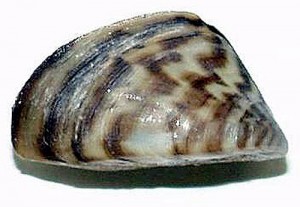The zebra mussel (Dreissena polymorpha) has finally established a population in California. A native of Europe, the zebra mussel lives in freshwater lakes and streams, and was likely transported to the United States in the ballast water of a trans-Atlantic freighter. In 1988 zebra mussels were found in Lake St. Claire and within a decade the mussel spread throughout all of the Great Lakes and into several major river basins.
Zebra mussels are hardy, surviving in a variety of freshwater and some slightly brackish habitats. Since zebra mussels cannot tolerate salinity much higher than 10 parts per thousand (ppt), they do not typically live in estuaries (e.g., Elkhorn Slough) and cannot survive in the ocean (35 ppt). Once established, zebra mussels are impossible to eradicate. Each female can produce 1 million eggs per year, floating larvae are microscopic and can drift miles before settling onto any hard surface. Adults (<5 cm) never move but do form extremely dense clusters that can cover boat hulls and clog pipes. The U.S. Fish and Wildlife Service estimates the potential economic impact to U.S. and Canadian water users within just the Great Lakes region will be $5 billion from 2000-2010.
The ecological impacts of zebra mussels vary depending on the type of ecosystem invaded. Zebra mussels filter water to feed, processing up to 1 gallon of water per day per mussel. In Lake Erie water clarity has increased from 15 cm to 9 m as the mussels removed microorganisms and organic material from the water column. However, some native filter feeder populations have begun to decline as a result of this competition with zebra mussels. In some systems zebra mussels have pushed native American freshwater clams to the brink of extinction. Zebra mussel adults attach to and overwhelm the native clams, reducing the clam’s ability to move, feed, and reproduce.
Zebra mussels are closely related to quagga mussels (Dreissena rostriformis bugensis), which first appeared in Lake Mead January 2007, and have subsequently spread through the Colorado River Aqueduct to reach several southern California reservoirs. Both of these freshwater mussels have the ability to cause incredible economic damage in California. While eradication of established populations is not possible, preventing their spread is feasible and requires boater owners to inspect their vessels on a regular basis for unwanted hitchhikers and to avoid infested bodies of water. The Department of Fish and Games has a toll-free information line at (866) 440-9530 or visit their website at: http://www.dfg.ca.gov/invasives/quaggamussel/
